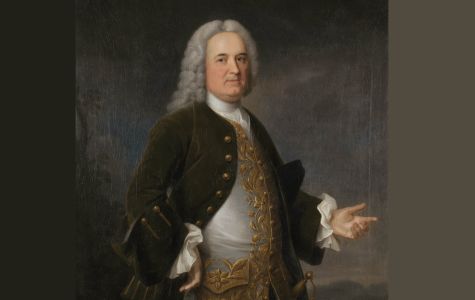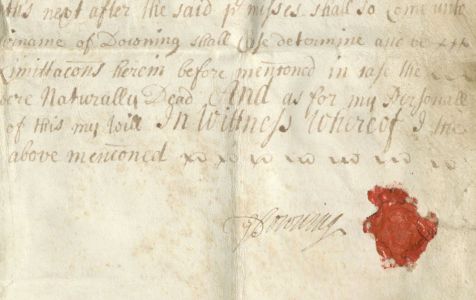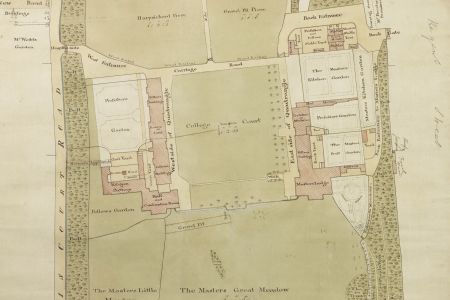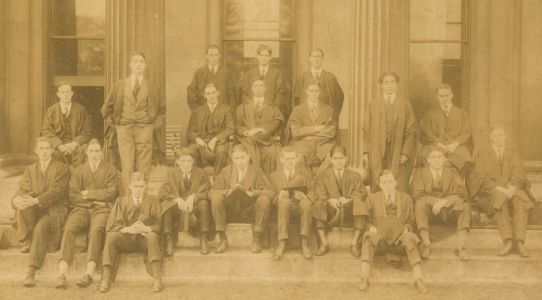Downing College history
Pre-foundation 1685-1800
Downing College was founded by Sir George Downing, 3rd Baronet. Much of the family's wealth was generated in the 17th century through the governmental career of his grandfather Sir George Downing, 1st Baronet, who served Cromwell and Charles II as well as building 10 Downing Street, the London home of the Prime Minister.
Sir George was born at East Hatley, West Cambridgeshire, in 1685 and was raised by his aunt following the death of his mother when George was only three. He was married to his cousin, Mary, when she was 13 and George only 15. Due to their age the couple never lived together as, in 1703, Mary went to London to become a Maid of Honour to Queen Anne against her husband's wishes.
In 1717 George obtained an Act of Parliament which gave legal sanction to his living apart from his wife without being divorced and he then made the will which led to the foundation of Downing College. With no hope of a legitimate heir, he left the estates to the next heir to the baronetcy, his cousin Jacob Garrard Downing. If Jacob died without heir, the estates would go to three cousins in succession. If all four died without issue, the estates were to be used to found a college at Cambridge called Downing.
George died in 1749 and Jacob in 1764, by which time the other named heirs had also passed away. The College should have come into existence then, but Jacob's widow, Margaret, refused to give up the estates. Sir George's legal heirs were forced to enter into expensive and lengthy legal action. Margaret died in 1778 but her second husband and nephew continued to resist until 1800 when the Court decided in favour of Sir George's will. Finally, Downing College was granted a Royal Charter.
Downing’s early architectural history
By this point the fortune which should have been used to found and maintain the College was so depleted, and the estates so neglected, that Downing began life poverty-stricken and with poor prospects.
Because of this, development of the College buildings has been slow. They were built on Pembroke Leys, a 30-acre area of small fields lying between Regent Street and Tennis Court Road. The first buildings were erected in 1807-1812, designed by William Wilkins (1775-1839) who had travelled in the Middle East and was greatly influenced by Greek architecture.
Until recently, Downing was the only Cambridge College to be designed as a whole, instead of being added to over time. Wilkins' original designs proposed four ranges around a quadrangle but funds ran out before these could be completed. For years only the East and West Ranges complemented the main Domus.
The East Range was built between 1807 and 1812. It included the Master's Lodge at the southern end but was not completed at the northern end until 1873. The West Range, with the Hall opposite the Master's Lodge, was built between 1818 and 1820.
Originally there was a free-standing Professor's house in each of the ranges but the intervening spaces have been built up and the former houses now provide seminar rooms and studies on the east and meeting rooms on the west.
The East Lodge is distinctive in that it was built in Portland stone, whereas the rest of the College has been built in Ketton stone. It’s to the latter that the College owes much of its beauty, especially on sunnier days.
Downing College in the 1900s
No further construction took place until 1931 when four residential blocks were built to the design of Sir Herbert Baker, in line with the East and West Ranges. Baker opted for a Roman-inspired design over Wilkins' Greek. The laboratories which the University built on former Downing land to the north, now known as the ‘Downing Site’, were still visible between the Baker buildings until 1953, when Baker’s partners, Scott and Helbing, finished the Chapel which completed the North Range.
The same architects also designed two blocks of rooms, erected in 1959 and 1961, beyond the west end of the Baker buildings, largely paid for by the two daughters of Professor C.S. Kenny, a distinguished Law Fellow, who is also commemorated by the Kenny Gate into Tennis Court Road.
In 1969, Professor W.G. Howell designed an enlargement of the Hall, adding a new Kitchen with offices and guest rooms above and a Senior Combination Room (or Fellows' meeting place), which has won several architectural prizes.
The 1980s saw a period of new building and refurbishment to equip Downing for its third century. First came the Howard Building, named after Dr Alan Howard, whose generosity has given to Downing an excellent building containing a reception room and a fully equipped flat floor concert and meeting room.
The stately residential block in the West Lodge Garden was completed in 1994 as a result of an appeal to old members and a further generous gift from the Howard Foundation. The architect of both buildings, Mr Quinlan Terry, is an exponent of classical architecture, whose design for the Howard Lodge is in keeping with the rest of the grounds.
Mr Terry was also the architect for the Butterfield Building which provides JCR and bar facilities, as well as a basement party room providing much appreciated facilities for student use. He was then commissioned to design the Maitland Robinson Library, a building named after Mr J.W.C. Maitland Robinson, a Downing graduate, whose magnificent gift enabled the construction and opening in 1993 of a purpose-built library for the first time in Downing's history.
The 21st century and beyond
The Singer Building, opened in the bicentenary year of 2000, has provided much-needed graduate accommodation. 2007 saw the restoration of the Hall to its original Georgian splendour. In 2010 the south side of the Howard Court was completed with the Howard Theatre, designed again by Quinlan Terry and his son, Francis.
The Georgian-style auditorium, modelled on William Wilkin's remaining working theatre, the Theatre Royal in Bury St. Edmunds, and the similar Richmond Theatre in Yorkshire, complements the 21st century green design of the building which incorporates ground-source heating and cooling, as well as grey water plumbing.
The Butterfield Bar was redesigned in 2012 to provide more space and a stylish café. In 2016 a new art gallery opened at Downing College, dedicated to modern and contemporary art. The art gallery is part of a larger construction project at Downing College containing 78 student rooms and eight common rooms. The project created a new court, called First Court, at the entrance to the College and the Edwardian stables (built in 1902-1903) were converted into the art gallery space. The Gallery was named by Alwyn Heong, an alumnus of Downing College, who is a passionate supporter of the visual arts and a collector. It was opened by Sir Alan Bowness at a ceremony on 5 February 2016.
See a detailed timeline of the history of Downing College.
Downing College Archive: Further information on the history of Downing College.
Plan of Downing College and historical context.
Downing College history
See a detailed timeline of the history of Downing College.




